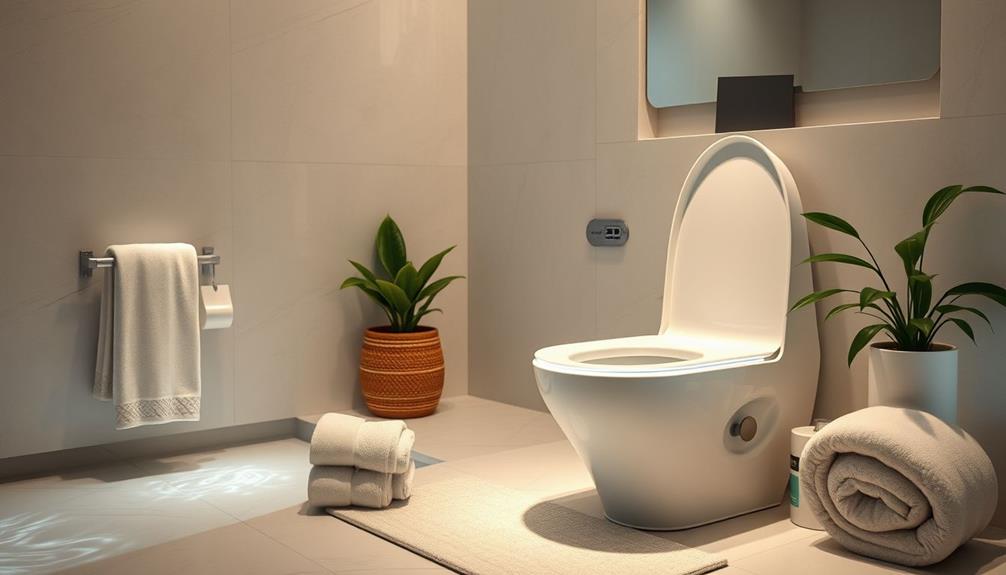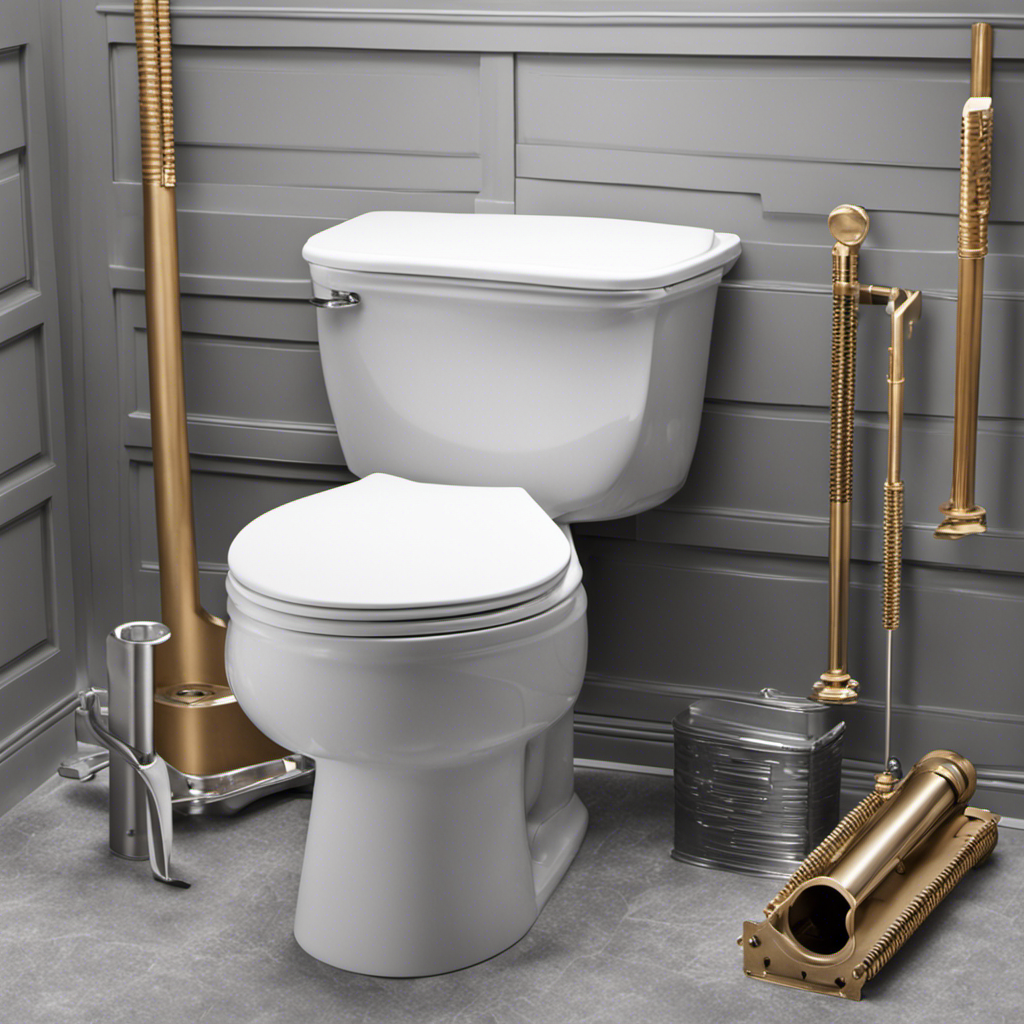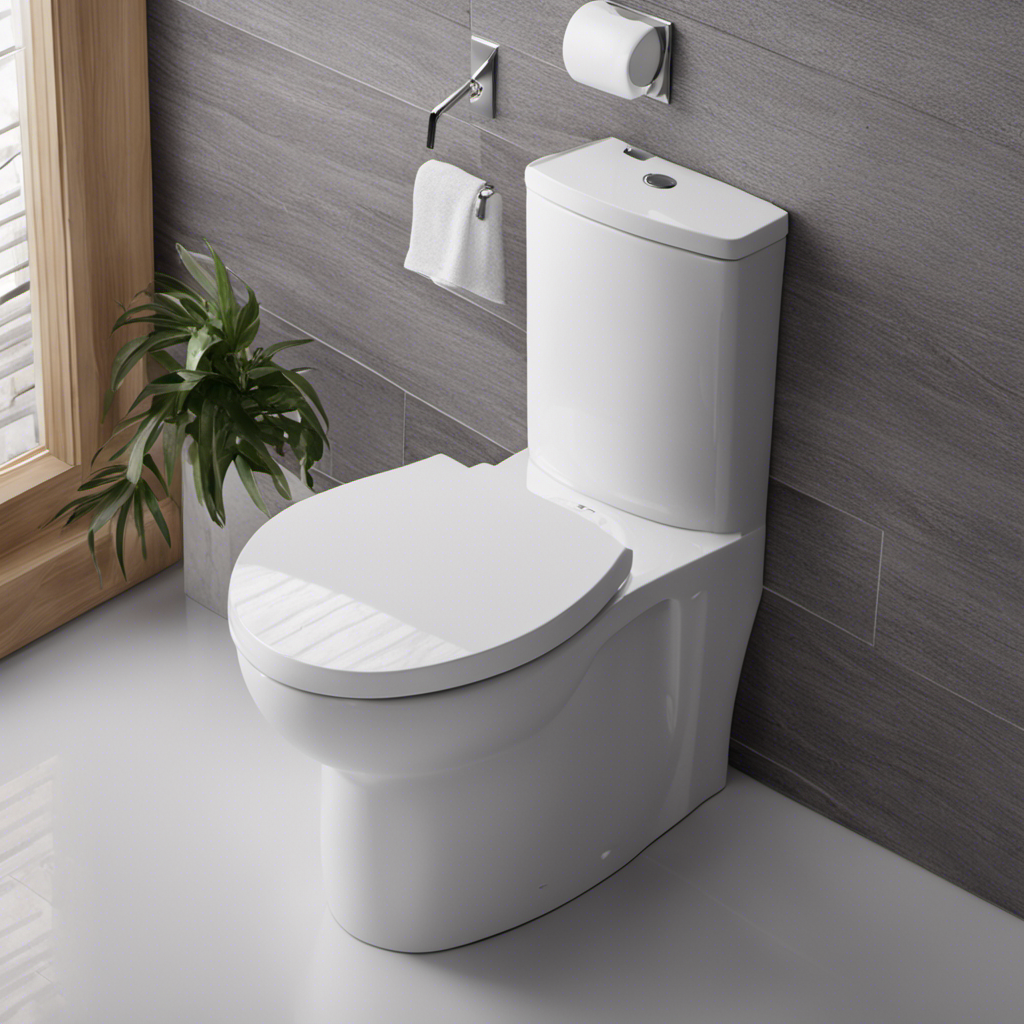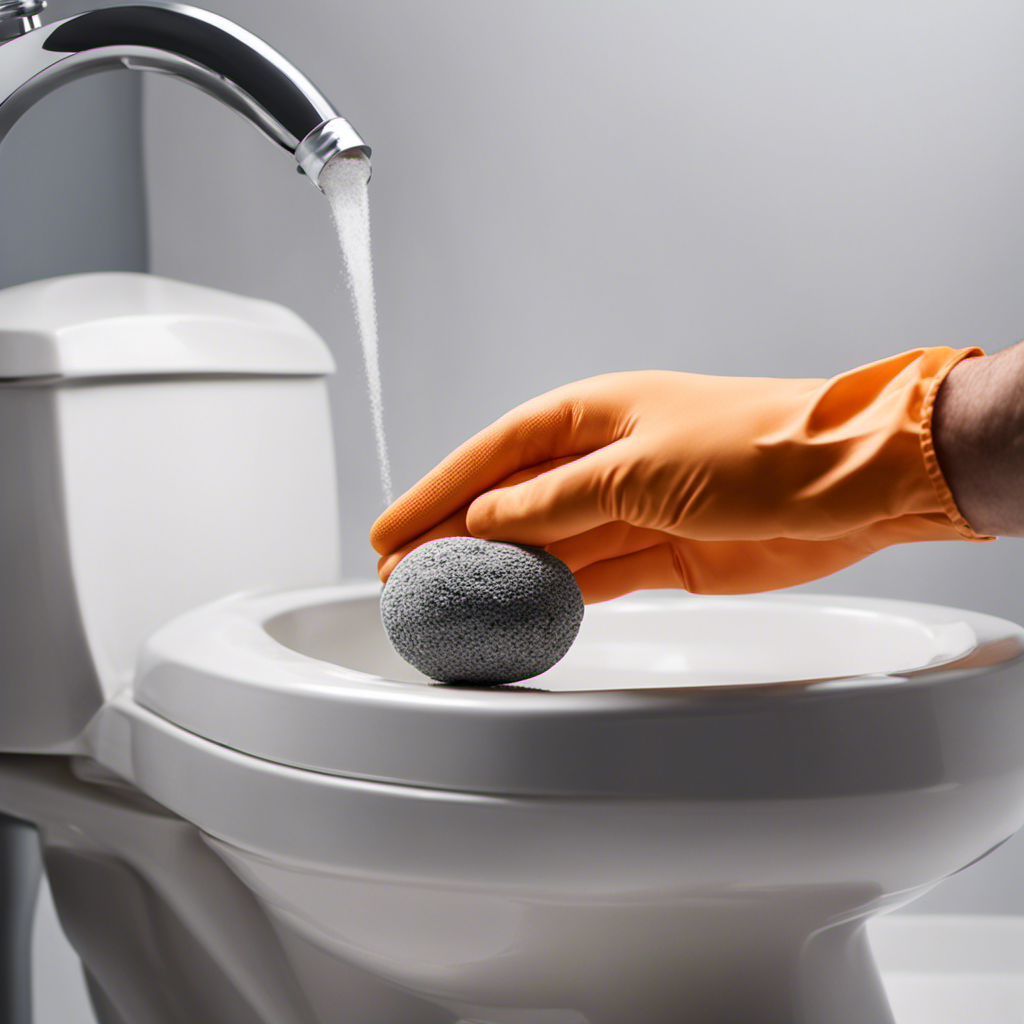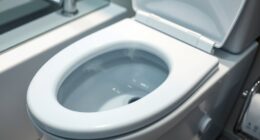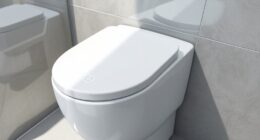When choosing between smart toilets and traditional toilets, you'll find that smart toilets offer comfort and advanced hygiene features. They include heated seats, built-in bidets, and automatic flushing, promoting a hands-free experience and customizable settings. While traditional toilets are budget-friendly and easier to install, they lack the modern conveniences that smart toilets provide. Though smart toilets come with higher upfront costs, their water efficiency and long-term savings on toilet paper can make them worthwhile. If you want a deeper understanding of the benefits and drawbacks of both, stick around for more insights.
Key Takeaways
- Smart toilets offer advanced features like bidets, heated seats, and automatic flushing, enhancing comfort and hygiene compared to traditional toilets.
- Traditional toilets are more budget-friendly, with costs ranging from $100 to $500, making them accessible for most households.
- Smart toilets can save 20-60% more water and reduce toilet paper usage, leading to long-term savings and environmental benefits.
- Maintenance for smart toilets is more complex due to electronic components, while traditional toilets require less frequent upkeep.
- User satisfaction is generally higher with smart toilets due to personalized settings and hands-free operation, improving the overall experience.
Definition of Smart Toilets
Smart toilets are innovative bathroom fixtures that combine technology with everyday hygiene to provide an enhanced user experience. Unlike traditional toilets, smart toilets come packed with advanced features designed to improve your comfort and cleanliness.
With built-in bidet functionality, these toilets can deliver targeted cleansing, elevating your hygiene routine considerably. Additionally, regular cleaning and maintenance, as emphasized in clogged toilet solutions, are critical to ensuring these modern fixtures function at their best.
You'll appreciate the convenience of automatic flushing, which eliminates the need to touch handles, promoting a touchless experience. Many models also boast adjustable water temperature and pressure settings, allowing you to customize your experience based on personal preferences. This level of user comfort is something standard toilets simply can't match.
Smart toilets are designed with water efficiency in mind, using less water compared to traditional toilets while still ensuring effective waste removal. Plus, some models even connect to Wi-Fi, giving you the ability to control settings via a smartphone app.
As smart toilets gain popularity worldwide, their superior cleaning capabilities and technological advancements make them an attractive alternative for those looking to enhance their bathroom experience.
With a projected growth rate of 15%, it's clear that consumers are enthusiastic for innovative and sustainable bathroom solutions.
Key Features Comparison
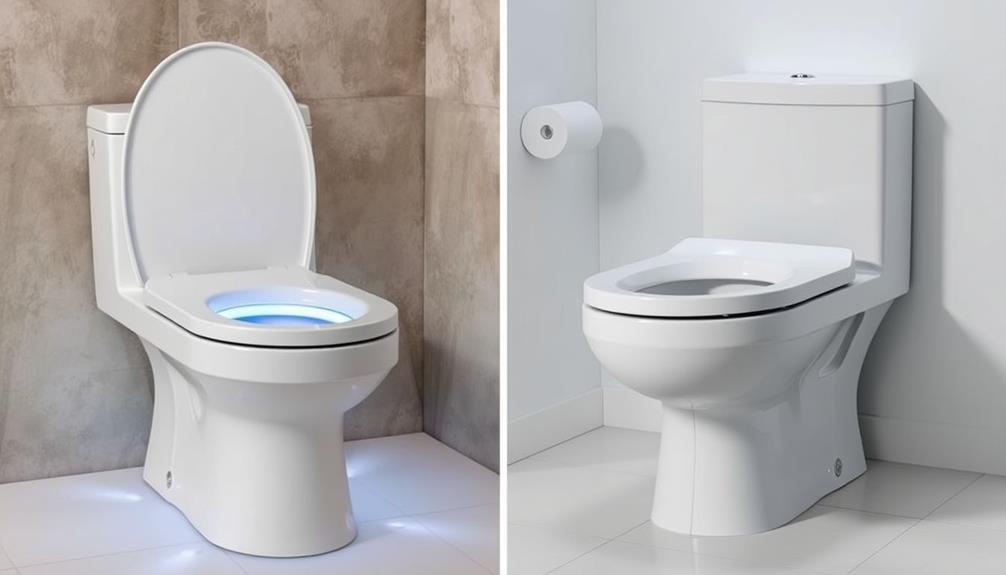
When comparing smart toilets to traditional ones, you'll notice a significant difference in advanced technology integration and user comfort.
Smart toilets offer features like heated seats and automated flushing that enhance hygiene and ease of use, while traditional models stick to the basics.
Additionally, just like air purifiers help alleviate allergy symptoms by improving indoor air quality, smart toilets can contribute to a cleaner bathroom environment.
However, it's crucial to weigh these benefits against the higher costs and maintenance needs of smart toilets.
Advanced Technology Integration
Advanced technology integration in modern toilets offers a stark contrast to traditional models, enhancing both comfort and hygiene. Smart toilets come packed with advanced features that elevate your bathroom experience. For instance, automatic flushing eliminates the need for manual operation, while sensors enable touchless lid opening and closing—something traditional toilets simply can't match.
Additionally, adopting a holistic lifestyle approach, such as maintaining proper hydration, can further support overall well-being, which may enhance your bathroom experience as well a holistic lifestyle approach.
When it comes to hygiene, smart toilets shine with self-cleaning mechanisms, utilizing UV light technology for enhanced hygiene that traditional toilets lack. You won't have to worry about bacteria buildup with such advanced cleaning methods.
Plus, the customizable water temperature and pressure settings for bidet functions provide a personalized cleaning experience, moving beyond the reliance on toilet paper typical of traditional toilets.
Water-saving features are also a key highlight of smart toilets. Many models incorporate dual-flush systems, greatly reducing water consumption compared to conventional designs. This not only benefits your wallet but also contributes to environmental sustainability.
To summarize, smart toilets leverage advanced technology to deliver unparalleled comfort and hygiene that leaves traditional toilets in the dust.
Comfort and Hygiene Enhancements
Transforming your bathroom experience, smart toilets offer a range of comfort and hygiene enhancements that traditional models simply can't provide. Imagine stepping into a space where every detail is designed for your ease:
- Heated seats for cozy comfort, especially in colder months.
- Integrated bidet functionality with customizable water temperature and pressure settings.
- Self-cleaning mechanisms and antimicrobial surfaces that minimize germs, similar to how cats exhibit signs of attachment to their owners through their environment.
- Automatic flushing and lid opening/closing to reduce contact with surfaces.
These features elevate your daily routine, making it not just about functionality, but also about an enjoyable experience.
Unlike traditional toilets, which rely on toilet paper, smart toilets provide superior cleaning through adjustable rinse options, enhancing your hygiene. The convenience of air drying and advanced odor control systems further sets them apart, promoting a fresher environment.
With smart toilets, you no longer have to compromise on comfort or cleanliness. The thoughtful design and advanced technology create a bathroom sanctuary that traditional toilets simply can't match.
Experience the future of personal hygiene and comfort right in your own home!
Cost and Maintenance Analysis
Smart toilets not only redefine comfort and hygiene but also bring a new dimension to cost and maintenance considerations. When you look at upfront costs, smart toilets typically range from $500 to over $5,000, while traditional toilets are much more budget-friendly, costing between $150 and $500.
Installation of smart toilets often needs professional help due to their advanced features, which can add to your overall expenses. In contrast, traditional toilets can usually be installed with basic DIY skills, saving you money.
Additionally, understanding the importance of thorough background checks can help homeowners make informed decisions when selecting contractors for installation.
Maintenance is another significant factor. Smart toilets require more complex upkeep, involving regular checks of electronic components and self-cleaning mechanisms. Traditional toilets, on the other hand, have simpler maintenance needs.
However, smart toilets can offer long-term savings through reduced toilet paper usage and lower water consumption, potentially offsetting their higher initial costs over time.
While traditional toilets can last many years with proper care, smart toilets might face technological issues that require repairs or part replacements due to their electronic components.
Weighing these factors will help you make the best choice for your bathroom needs.
Advantages of Smart Toilets
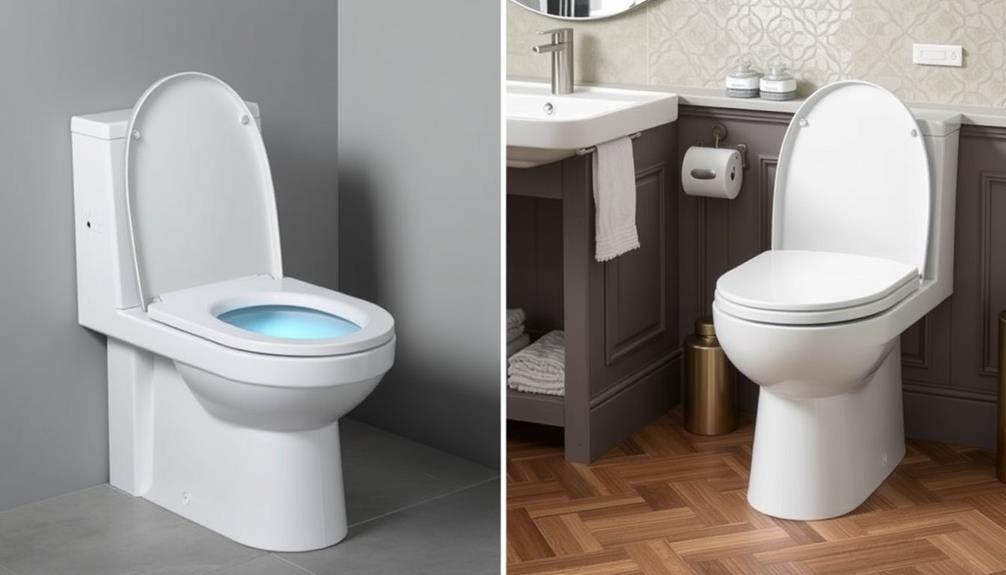
While traditional toilets have their merits, smart toilets bring a host of advantages that enhance your bathroom experience. These innovative fixtures incorporate advanced features that prioritize comfort, hygiene, and sustainability, making them a worthy investment.
Additionally, the convenience of encouraging social interactions in a family setting can be mirrored in the modern bathroom with smart technology.
- Enhanced hygiene: Built-in bidets reduce reliance on toilet paper, promoting a cleaner bathroom experience.
- Personalized experience: From heated seats to customizable water pressure and temperature settings, smart toilets cater to your preferences.
- Water-efficient designs: Many models include dual-flush systems and energy-saving modes, considerably lowering water consumption compared to traditional toilets.
- Health monitoring systems: Some smart toilets track user health metrics, offering potential health benefits and contributing to overall well-being.
With their ability to enhance hygiene and provide a personalized experience, water-efficient smart toilets are an eco-friendly choice.
They also feature advanced accessibility options, making them user-friendly for individuals with mobility issues.
Installation and Maintenance

Installing and maintaining a smart toilet can be quite different from dealing with traditional models. Smart toilets usually require professional installation because their complex plumbing and electronic components demand expertise. Additionally, choosing a home cleaning service can be beneficial for keeping the surrounding areas clean and well-maintained, especially with the added features of smart toilets.
In contrast, traditional toilets can often be set up by DIY enthusiasts with basic plumbing knowledge, making installation easier and more cost-effective.
When it comes to maintenance, smart toilets need regular checks on their electronic components and sensors to guarantee everything runs smoothly. You'll also need to clean bidet nozzles frequently for peak functionality.
On the other hand, traditional toilets generally call for less frequent upkeep, focusing mainly on the mechanical parts.
Additionally, smart toilets may require replacement parts for their advanced features, which can be more costly and specialized compared to the simpler components of traditional toilets. The user manuals for smart toilets often include troubleshooting guides due to their advanced technology, whereas traditional toilets offer straightforward maintenance instructions.
Cost Analysis
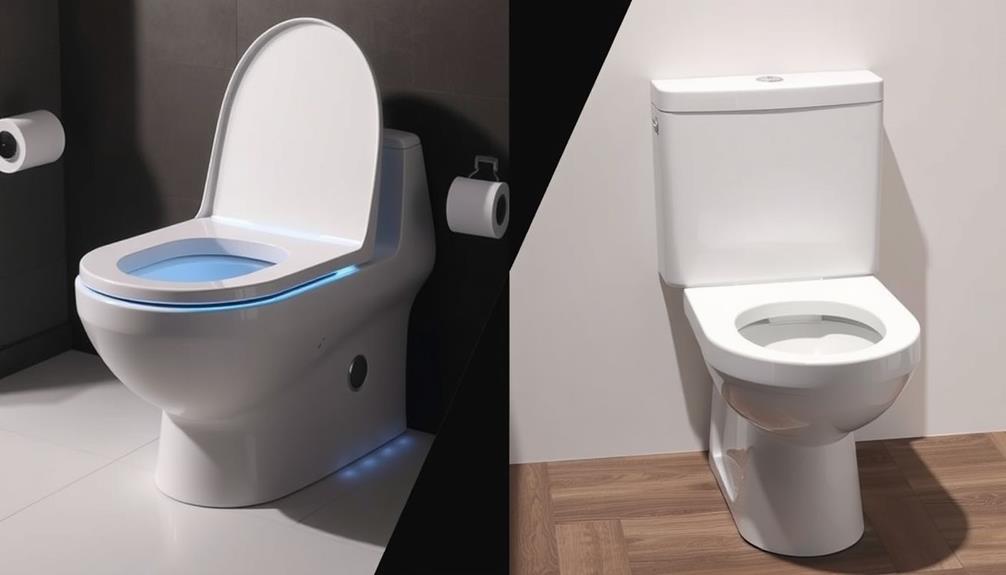
When you're weighing the costs of smart toilets against traditional ones, you'll notice a significant difference in initial investments. Smart toilets often come with a price tag ranging from $500 to over $5,000, while traditional models start at just $100.
However, consider the potential long-term savings on water bills and reduced toilet paper usage that smart toilets might offer. Additionally, some people find that the advanced features of smart toilets, such as user-friendly features, enhance their overall bathroom experience.
Ultimately, the decision may come down to what you value more: modern convenience or budget-friendly options.
Initial Investment Comparison
Considering the considerable price differences, comparing the initial investment for smart toilets and traditional ones is essential. Smart toilets generally come with a heftier price tag, ranging from $500 to over $5,000, while traditional toilets cost between $100 to $500. This means the initial investment for smart models can be 2-3 times higher than their traditional counterparts.
Additionally, modern homes often integrate advanced technology into various fixtures, including bathrooms, making smart toilets a fitting choice for those aiming for a cohesive look in their space with modern farmhouse decor trends.
Here's a quick breakdown of what to expect:
- Basic smart toilets: $500 – $800
- Mid-range smart toilets: $800 – $1,500
- High-end smart toilets: $1,500+
- Traditional toilets: $100 – $500
Installation costs also vary considerably. Smart toilets often require specialized installation, which can add to your upfront costs, while traditional toilets may be suitable for DIY installation, keeping expenses lower.
Although the initial investment for smart toilets is higher, their advanced features may offer enhanced hygiene and water efficiency. You might consider that these features could lead to long-term savings on water and toilet paper, potentially offsetting the higher upfront costs over time.
Long-term Savings Potential
Long-term savings potential is an essential factor to weigh when deciding between smart and traditional toilets. While smart toilets come with a higher initial price, usually between $1,000 and $5,000, they offer significant long-term savings. Their efficient flushing systems can save you 20-60% more water compared to traditional models, especially with dual-flush options and eco-friendly modes. This translates to lower water bills over time.
Additionally, much like investing in a Gold IRA for long-term wealth preservation, choosing smart toilets can result in better financial resilience due to their efficiency and reduced resource consumption Gold IRAs provide a hedge against inflation.
Moreover, smart toilets reduce your reliance on toilet paper, cutting ongoing expenses and minimizing environmental impact. Although maintenance costs may be higher at first, their advanced self-cleaning features mean you'll spend less time and money on cleaning products in the long run.
Investing in a smart toilet also boosts your property value, particularly in luxury markets. This investment value can provide a return that outweighs your initial purchase and installation costs.
Water and Energy Efficiency

Smart toilets are revolutionizing water and energy efficiency in modern bathrooms. By incorporating advanced features like dual-flush systems and eco-mode settings, these innovative fixtures allow you to customize your water usage. You can choose between a full flush and a reduced flush, dramatically cutting down on water consumption compared to traditional toilets that rely on a single flush mechanism.
Here are some key advantages of smart toilets:
- Improved water efficiency: Reduce water usage by 20-30% compared to standard models.
- Lower water usage: Some smart toilets use as little as 1.28 gallons per flush.
- Long-term savings on water: Potentially save up to 12,000 gallons annually per household.
- Energy consumption management: Many models feature energy-saving modes to minimize energy use.
While smart toilets do require electricity for their advanced features, the overall benefits often outweigh the increased energy consumption.
With smart toilets, you're not only helping the environment but also making a smart investment in your home's water efficiency. Shifting to such a system can lead to substantial long-term savings on water and contribute to a more sustainable lifestyle.
User Experience Considerations
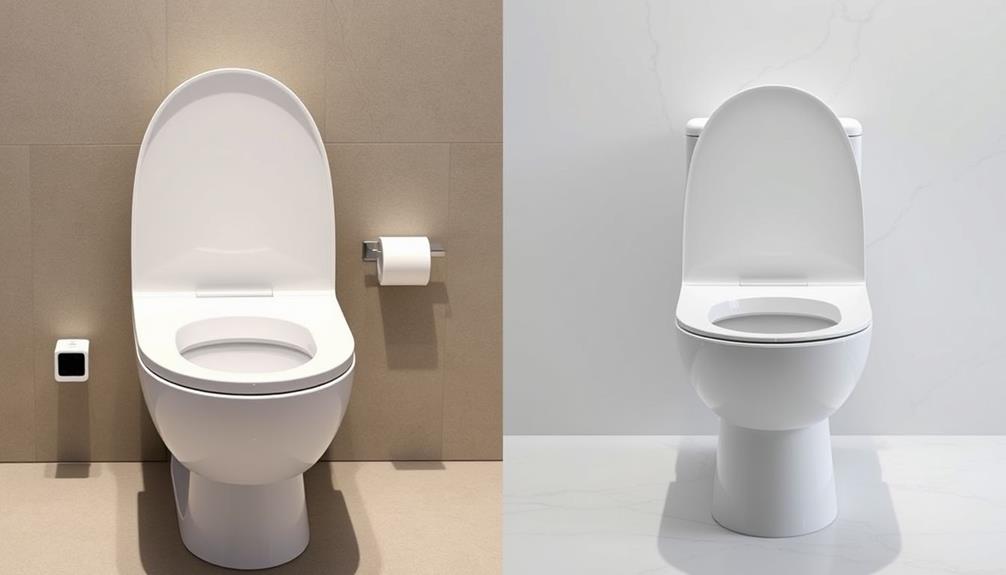
The experience of using a toilet can greatly influence your daily routine, and smart toilets elevate this experience with their advanced features. Unlike traditional toilets that require manual operation, smart toilets provide a hands-free user experience with automatic flushing and lid opening/closing. This convenience enhances your overall comfort.
User comfort is considerably improved with smart toilets, especially through features like heated seats, which are a welcome luxury in colder climates. Additionally, the customizable rinse settings allow for a more tailored and hygienic cleaning experience, reducing reliance on toilet paper that can cause irritation.
Smart toilets also include self-cleaning features that promote better hygiene and lessen the frequency of manual cleaning. This contrasts sharply with traditional toilets, which demand regular upkeep without the benefit of automated assistance.
Users of smart toilets often report higher satisfaction levels, thanks to the personalized settings and advanced technology that elevate personal hygiene.
When considering user experience, it's clear that smart toilets offer a superior alternative to traditional toilets, making them a worthwhile investment for comfort and convenience in your daily life.
Frequently Asked Questions
What Is the Difference Between a Smart Toilet and a Traditional Toilet?
A smart toilet offers advanced features like automatic flushing and heated seats, enhancing comfort and hygiene. In contrast, a traditional toilet relies on manual operation, providing a simpler, more cost-effective option for everyday use.
What Are the Cons of Smart Toilets?
Smart toilets can feel like a high-tech dream, but they come with downsides. You'll face steep costs, tricky installations, and potential tech issues. Maintenance can be a hassle, too, demanding your attention regularly.
Are Smart Toilets Worth It?
If you're considering a smart toilet, think about the long-term savings on toilet paper and water bills. The advanced features enhance hygiene and comfort, making it a worthwhile investment for many users.
What Is the Point of a Smart Toilet?
Think of a smart toilet as your bathroom's personal assistant. It enhances hygiene, comfort, and convenience with features like automatic flushing and bidet functions, transforming your daily routine into a more efficient and enjoyable experience.
Conclusion
In the battle of smart toilets versus traditional ones, it's clear that modern technology offers a wealth of benefits. While traditional toilets serve their purpose, smart toilets elevate your bathroom experience to new heights. With features designed for comfort and efficiency, investing in a smart toilet is like upgrading from a flip phone to a smartphone—once you try it, you'll wonder how you ever lived without it. Embrace innovation and transform your daily routine today!

